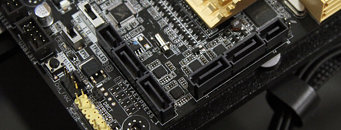- Joined
- Dec 6, 2011
- Messages
- 4,784 (1.01/day)
- Location
- Still on the East Side
ASUS today announced that research and development work supported by Intel has led to the discovery of a BIOS structure that unleashes the true full potential of the latest SATA Express interface standard on future ASUS motherboards. Following the CES 2014 debut of the ASUS Z87-Deluxe/SATA Express concept motherboard, ASUS and Intel continued working together to ensure that users enjoy the full performance of the SATA Express interface and SATA Express components.
The joint research effort means that ASUS is the first motherboard manufacturer in the world to discover and implement a technology that is critical for SATA Express to perform at its best - the Separate Reference Clock with Independent Spread Spectrum Clocking Architecture, or SRIS for short.

In order to identify and validate this exciting and valuable breakthrough, ASUS developed Hyper Express, an exclusive 2.5-inch SATA Express external enclosure. This smart invention is a concept device that accommodates two mSATA devices and enabled ASUS engineers to measure extensively SATA Express interface design, allowing us to finely engineer new motherboard designs to unleash the new standard's full speed.
Full-speed SATA Express with SRIS in the BIOS
In order to deliver the full potential of SATA Express, the host motherboard must contain the SRIS architecture in the BIOS. It ensures that the crucial timings between the high-speed SATA Express device and the motherboard are kept precisely in tune. Users of future ASUS motherboards will enjoy sequential read/write speeds of up to 745/809 MB/s - so fast that a 10 GB full-length HD movie transfers in around 10 seconds!
SRIS ensures the best SATA Express compatibility
In addition to unleashing the full speed of SATA Express, the ASUS SRIS breakthrough provides consumers with numerous other advantages.
SATA Express-capable motherboards that lack the SRIS architecture in the BIOS could present compatibility problems. SATA Express devices might not be recognized, for example; or recognized devices might not work correctly. Even in situations where SATA Express devices are recognized and appear to function correctly, their true performance could be hindered by lack of SRIS BIOS implementation.
The discovery and development of SRIS is another world first for ASUS and cements our position as the industry's leading motherboard manufacturer. Our SATA Express solution is the only one to have undergone full SRIS testing and validation to ensure the true potential of the interface is realized - and that means that only buyers of forthcoming ASUS motherboards are assured the very best SATA Express performance.
The SRIS BIOS technology will be available worldwide in future ASUS motherboards.
View at TechPowerUp Main Site
The joint research effort means that ASUS is the first motherboard manufacturer in the world to discover and implement a technology that is critical for SATA Express to perform at its best - the Separate Reference Clock with Independent Spread Spectrum Clocking Architecture, or SRIS for short.

In order to identify and validate this exciting and valuable breakthrough, ASUS developed Hyper Express, an exclusive 2.5-inch SATA Express external enclosure. This smart invention is a concept device that accommodates two mSATA devices and enabled ASUS engineers to measure extensively SATA Express interface design, allowing us to finely engineer new motherboard designs to unleash the new standard's full speed.
Full-speed SATA Express with SRIS in the BIOS
In order to deliver the full potential of SATA Express, the host motherboard must contain the SRIS architecture in the BIOS. It ensures that the crucial timings between the high-speed SATA Express device and the motherboard are kept precisely in tune. Users of future ASUS motherboards will enjoy sequential read/write speeds of up to 745/809 MB/s - so fast that a 10 GB full-length HD movie transfers in around 10 seconds!
SRIS ensures the best SATA Express compatibility
In addition to unleashing the full speed of SATA Express, the ASUS SRIS breakthrough provides consumers with numerous other advantages.
SATA Express-capable motherboards that lack the SRIS architecture in the BIOS could present compatibility problems. SATA Express devices might not be recognized, for example; or recognized devices might not work correctly. Even in situations where SATA Express devices are recognized and appear to function correctly, their true performance could be hindered by lack of SRIS BIOS implementation.
The discovery and development of SRIS is another world first for ASUS and cements our position as the industry's leading motherboard manufacturer. Our SATA Express solution is the only one to have undergone full SRIS testing and validation to ensure the true potential of the interface is realized - and that means that only buyers of forthcoming ASUS motherboards are assured the very best SATA Express performance.
The SRIS BIOS technology will be available worldwide in future ASUS motherboards.
View at TechPowerUp Main Site








